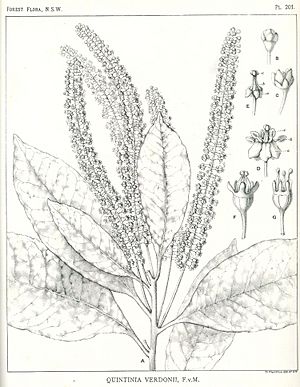Grey possumwood facts for kids
Quick facts for kids Grey possumwood |
|
|---|---|
 |
|
| Young tree at Mount Banda Banda, Australia | |
 |
|
| Drawing by Margaret Flockton | |
| Scientific classification | |
| Genus: |
Quintinia
|
| Species: |
verdonii
|
The Quintinia verdonii, also known as the grey possumwood, is a type of tree that grows in eastern Australia. You can mostly find it in rainforests, especially in high places. It naturally grows from the Barrington Tops area in New South Wales all the way up to the Blackall Range in Queensland.
Contents
About the Grey Possumwood Tree
The grey possumwood is a small to medium-sized tree. It can grow up to 17 metres (about 56 feet) tall. Its main stem, called the trunk, can be up to 30 centimetres (about 12 inches) wide.
You can tell it apart from a similar tree, the regular possumwood (Quintinia sieberi). The grey possumwood has smoother bark. Its smaller branches are also lighter in colour. The regular possumwood has tiny reddish glands under its leaves, but the grey possumwood has clear, colourless glands. Also, the regular possumwood's flowers grow in branched clusters called panicles. The grey possumwood's flowers grow in simpler, unbranched clusters called racemes.
Trunk and Branches
The main trunk of the grey possumwood is usually straight and round. Its bark is smooth and a pale grey colour. It feels a bit soft, like cork. The smaller branches are quite thick and smooth. You can see marks on the branchlets (the very small branches) where old leaves used to be. The tips of these branchlets are often purple or dark red.
Leaves
The leaves of the grey possumwood grow one after another along the stem. They are shaped like an oval or ellipse, with a short, blunt tip. These leaves are smooth and feel leathery. On grown trees, they are usually 5 to 15 centimetres (about 2 to 6 inches) long. They are also 1.5 to 5 centimetres (about 0.6 to 2 inches) wide.
The top side of the leaf is dark green, and the underside is a lighter green. If you look closely at the underside, you might see tiny, clear glands. The stalks that connect the leaves to the branch are about 1 to 2 centimetres (about 0.4 to 0.8 inches) long and are often twisted.
The main veins on the leaves are easy to see and stick out on the underside. They are less noticeable on the top. There are usually 12 to 20 of these veins. They grow out from the middle vein at an angle of about 75 degrees. Most of these veins are straight, but they curve a little where they reach the edge of the leaf. The smaller net-like veins are very hard to see on the top side. Young leaves that grow from the trunk or old branches (called coppice leaves) might have very faint teeth along their edges. However, the leaves on mature trees have smooth, untoothed edges.
Flowers
The grey possumwood produces white, cream, or yellow flowers. Each flower has five petals. These flowers grow in single, narrow clusters called racemes. They appear in the upper parts of where the leaves meet the stem (called the axils). You can usually see them from September to November.
The stalk that holds the flower cluster is about 3 to 4 millimetres long. The petals of each flower are small, only 2 to 3 millimetres long. After the flowers, small, half-round fruit capsules form. These fruits ripen from December to January.
How it Grows and Reproduces
The seeds of the grey possumwood are very light and are carried by the wind. They often start growing on the trunks of other plants, like rocks or Soft tree ferns (Dicksonia antarctica). This is called being a hemiepiphyte. It means the plant starts growing on another plant but eventually sends its roots down to the ground.
Because the roots of the young seedlings are so tiny, they need special care. They need enough moisture and protection so they don't get buried too deep or left out in the open. For the small seeds to grow well, they need the right kind of soil. It's best to lightly cover the seeds with a special potting mix for starting seeds. It's not too hard to grow new grey possumwood trees from either seeds or cuttings.
Timber and Use in Gardens
The wood of the grey possumwood is soft and has a pink colour. It's not usually used for commercial purposes like building. However, this tree has many beautiful flowers, which means it could be a great plant for gardens.
More than a hundred years ago, a person named Joseph Maiden suggested that this tree would grow well in gardens along the east coast of Australia. But it hasn't become a widely planted garden tree as he thought it might. It grows easily in soil that drains well but also stays moist. It likes sunny spots or places with some shelter. The Quintinia verdonii can also handle moderate frosts.
Naming the Tree
The second part of the tree's scientific name, verdonii, honours a politician named George Frederic Verdon. The famous botanist Ferdinand von Mueller officially described this plant in 1861. He used samples collected by Hermann Beckler from the Manning and Hasting Rivers. Sometimes, people call this tree the "smooth possumwood" because its bark is smoother than that of its relatives.
Ecology
The grey possumwood tree is a home for a special type of moth called Lyonetia lechrioscia. This moth is a leaf miner, meaning its larvae (caterpillars) live inside and eat the leaves of the tree.

